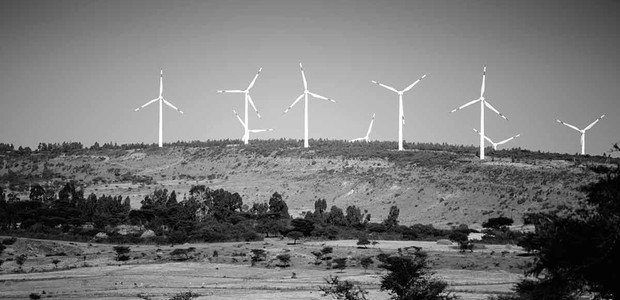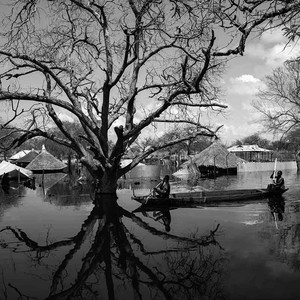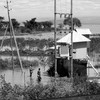re‹think policies & investmentsGreen investments to battle climate change

Ethiopia, Egypt and Sudan are caught in an enormous geopolitical cold war over the usage of the Blue Nile and the operation of the Great Ethiopian Renaissance Dam (GERD). The United Nations Security Council (UNSC) has convened, with others criticising and commenting upon the mounting tension. Meanwhile, the greatest threat in the Nile Basin, climate change, is being ignored.
The world’s climate is already, on average, one degree Celsius warmer than in preindustrial times due to rising global greenhouse gas concentrations. The Intergovernmental Panel on Climate Change (IPCC) predicts that increases in global mean temperature by one to three degrees Celsius above 1990 levels will benefit some regions and harm others.
The Nile Basin, Africa’s most significant ecosystem, since it hosts over 40 percent of Africa’s population (about 490 million people), is already in the firm grip of climate change.
According to United Nations Environment Programme (UNEP), the challenges emanating from climate change in the Nile Basin include uncertainty regarding precipitation and river flow, land degradation, reduced river flow, flooding, droughts, deforestation, and loss of species and ecosystems and increased incidences of disease.
Massive infrastructure damages, loss of human lives, and Internally Displaced Peoples (IDPs) have been observed, especially in the last three years due to torrential rains that led to flooding amid intense GERD debates.
Just last August 2020, Sudan suffered from massive flooding that displaced more than 600.000 people, collapsed several houses and damaged agricultural lands and infrastructures, according to the United Nations Office for the Coordination of Humanitarian Affairs (OCHA). If the GERD reservoir had not held 4.5 million cubic metres of water in that rainy season, the damages would have worsened.
Rethinking investments in agriculture
According to the Global Investment Bank of Credit Suisse, investing with climate change and a low-carbon economy in mind is part of managing the material risk to the company’s portfolio. Investors who acquire lands and seek to decarbonise their portfolio may likely find low-carbon investments in the Nile Basins’ new energy and agro-processing industries, even though some citizens oppose the Gulf investors’ growing interest in grabbing the Nile Basin’s agricultural wetlands.
Even though climate change further exacerbates the water stress, already up to 10.3 million hectares of land have been acquired by investors across the 11 Nile Basin countries since 2000. According to the Pulitzer Centre, most of these lands were allocated in 28 transnational deals. Companies from mainly Middle Eastern states acquired vast land areas to produce food crops, animal feed such as alfalfa and biofuels.
Including ecosystem services can improve how decisions are made.”
The water chain of food production and climate change impacts need a rethink: Water experts have been suggesting that a coordinated water management system should be in place to address water risks or stress.
The biggest challenge is at the private-sector level. Most players believe that the water crisis is the governments’ responsibility.
Interestingly, within the six years since the launch of the United Nations Sustainable Development Goals (SDGs), some global savvy and responsible investors have started to measure their operations and output with these objectives to demonstrate how their investments can better align with the UN’s framework. So, there are likely to be signs of such commitments from investors in the Nile Basin and mechanisms for the management and monitoring from the state actors.
Although developed nations are historically responsible for the changing climate and thus have an obligation to finance climate adaptation projects in developing countries, the debate around the Common But Differentiated Responsibilities (CBDR), formalised in the United Nations Framework Convention on Climate Change of Earth Summit in Rio de Janeiro, 1992, has not yet been resolved. So the Nile Basin nations must generate finances from private and public sectors by implementing ecosystem services to adapt to climate effects and ensure a sustainable flow of Nile waters.
In consideration of developing models of how ecosystems produce services at the scale necessary to examine regional, national, and global outcomes and the quantitative benefits of the ecosystem and habitat restoration, the Nile Basin Initiative (NBI) and the Regional Wetlands Expert Working Group have developed a wetland atlas with the support of the Deutsche Gesellschaft für Internationale Zusammenarbeit (GIZ).
The management plans have been developed for three transboundary wetland landscapes Sio-Siteko (Kenya - Uganda), Semliki (Uganda - DR Congo) and Sango/Minziro Forest (Uganda - Tanzania), which the member countries adopted in 2020. However, Lake Tana wetland, registered by UNESCO as World Biosphere Reserve, and the Blue Nile’s source is missing.
According to National Ecosystem Services Partnership (NESP), an initiative at Duke University’s Nicholas Institute for Environmental Policy Solutions, including ecosystem services in decision making, can improve how decisions are made and communicated to the public. Failure to include ecosystem services in decision making can shrink the benefits ecosystems provide.
Climate change investments in agriculture and implementing ecosystem services contribute directly to several of the SDGs: 2 (zero hunger); 12 (responsible consumption and production); 13 (climate action); and potentially 15 (life on land) – as the Nile riparian states will need less land for agriculture if they can establish a mechanism to administer investors jointly under a river basin organisation.
Installing a proper water management system within the supply chains of listed agricultural companies in the basin is key to achieving water and food security.
Rethinking investments in energy
Climate change is a severe threat that is impacting energy-hungry poor economies. However, the idea of integrating sustainability considerations into investment processes could contribute to the UN’s Deep Decarbonisation Pathways Project (DDPP) goal of achieving a net-zero emission by 2050.
Technologies that address climate change, like green energy and sustainable transport, are likely to profit as investors look for options that remove carbon from the world. For instance, Ethiopia is generating green power from the GERD. In the meantime, the reservoir could be used for floating solar photovoltaic systems that would boost the energy generating capacity.
Climate services enable decision-makers to manage risks.”
According to a World Bank report investing in floating solar photovoltaic is effective, especially in countries with high population density and competing uses for available land. The advantages of floating over land-based solar systems include higher energy yield, reduced evaporation, and improved water quality.
On the other hand, investors need to consider climate-related mitigation and adaptation strategies in an active way to develop climate resilience and manage climate risks in their portfolios. Policymakers need to create a mechanism to make it effective and thus benefit all Nile riparian states. And, the urgently needed effective action on climate change investments requires a coordinated mechanism by all Nile Basin nations.
What the NBI has worked on so far
As the only existing Nile Basin organisation, the NBI has commissioned many studies at sub-basin and basin-wide levels to improve the understanding of the water resources and socio-economic situation, vulnerability to climate change, appropriate coping measures and development options. It has also supported science-policy dialogue, strengthening basin monitoring and planning tools, and facilitating the expansion of water and power infrastructures.
NBI’s Climate Services feature collected information and data from all Nile Basin countries, except Egypt and Tanzania, on various water‐related sectors like energy, agriculture and infrastructure (dams, irrigation schemes, etc.). The aim is to “make decision-makers and their technical support structures use Climate Services in planning and climate risk assessment in infrastructure investment”.
According to the NBI’s Climate Services for Infrastructure Baseline Assessment report, climate services enable public and private decision‐makers to manage climate risks and opportunities and raise the resilience of national infrastructures. Many countries within the Nile Basin region so far lack the institutional, technical and service‐related capacity they need to set up and mainstream climate services in their planning procedures and regulations, the report commends.
NBI is also working on drought monitoring with the Nile Basin River Flow Forecasting System (NB-RFFS). The report is automatically generated by the Flood and Drought Data Portal, which contains the latest satellite imagery used to monitor precipitation, soil moisture, and vegetation health to support the drought early warning system.






